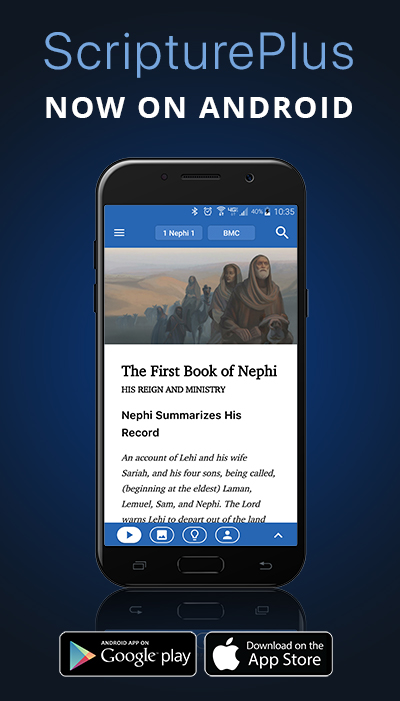/ KnoWhys / KnoWhy #613
Why Study Ancient Apocryphal Literature?

Post contributed by BMC Team
August 10, 2021
D&C KnoWhy #613

“Verily, thus saith the Lord unto you concerning the Apocrypha—There are many things contained therein that are true, and it is mostly translated correctly. … Therefore, whoso readeth it, let him understand, for the Spirit manifesteth truth; and whoso is enlightened by the Spirit shall obtain benefit therefrom.”
The Know
Most Latter-day Saints today are unfamiliar with the collection of books commonly called the Apocrypha (Greek for “hidden”). These are works of Jewish literature, some of a religious nature, primarily written in Greek between the third century BC and the first century AD (see the appendix for a list of books that compose the Apocrypha). They were included as part of the Septuagint (the Greek translation of the Hebrew Bible/Old Testament), and as a result were included as part of the biblical canon by some early Christians. To this day, they form what is called the deuterocanonical books in Catholic and Orthodox Christianity.1
Because these works were mostly written during the intertestamental period—that is, the time between the Old and New Testaments—studying them can help bridge the cultural, religious, and historical gap between the end of the Old Testament and the beginning of the New.2 Thus, as Jared Ludlow explained, “the Apocrypha can be a valuable tool for helping us understand the political, cultural, and religious background of Jesus Christ and his contemporaries.”3
List of books in the Apocrypha
- Baruch and the Epistle of Jeremiah
- Prayer of Manasseh
- 1 Esdras (3 Ezra)
- 2 Esdras (4 Ezra)
- Judith
- Tobit
- 1 Maccabees
- 2 Maccabees
- Ben Sirach (Ecclesiasticus)
- Wisdom of Solomon
- Additions to Esther and Daniel
Some Christian churches also include
- Psalm 151
- 3 Maccabees
- 4 Maccabees
Beyond the “official” collection of the Apocrypha, there are several additional Judeo-Christian writings from around the same time period that are sometimes referred to as the apocryphal literature. This includes the pseudepigraphal works—texts written in the first person as if they were written by a famous biblical figure, such as Moses, Enoch, Solomon, or one of the Patriarchs.4 Many texts from the Dead Sea Scrolls could also be described as apocryphal.5 There is also the New Testament Apocrypha, which consists of non-canonical Gospels, early Christian pseudepigrapha, and other writings that were important to ancient Christians but were ultimately excluded from the canon.6
Hugh Nibley was among the first Latter-day Saints to seriously study this vast corpus of ancient literature, discovering many parallels to Restoration scripture and teachings.7 Other Latter-day Saints have since built on Nibley’s legacy. For example, Nibley conducted a detailed study of 3 Nephi in comparison with the early Christian writings known as the 40-day literature and found numerous striking parallels.8 Others have built on this work, finding that 3 Nephi comfortably fits into the Gospel genre of early Christian writings.9
Many Restoration teachings can be found in apocryphal books. For example, some passages in the Wisdom of Solomon, one of the books in the official Apocrypha, teach of the “pre-mortal existence of the soul.”10 Ben Sirach, another book in the Apocrypha, “has several wisdom sayings related to the family and the importance of raising children in righteousness,” which resonates with the Latter-day Saint “focus on family.”11 The broader corpus of apocryphal literature includes extensive traditions related to Enoch, many of which have similarities with details found in Moses 6–7.12
The Why
Clearly, there is much in common between these ancient texts and the doctrines and scriptures of the Restoration. As Robert J. Matthews rightly noted, “there is much interesting and useful reading in the apocryphal literature … [and] the presence in latter-day revelation of ideas and names not found in the Bible but found in apocryphal writings should quicken our interest in these ancient writings.”13 Yet Matthews also noted that “much apocryphal literature is obviously spurious.”14 Indeed, not everything in the Apocrypha, and apocryphal literature more broadly defined, is consistent with Restoration scripture and teachings.
As the Lord revealed to Joseph Smith, “concerning the Apocrypha—There are many things contained therein that are true, and it is mostly translated correctly; there are many things contained therein that are not true, which are interpolations by the hands of men” (Doctrine and Covenants 91:1–2). The Lord further assured Joseph that those who read the Apocrypha with guidance from the Spirit “shall obtain benefit therefrom” (D&C 91:4–5).
This same guidance and counsel surely apply to other ancient apocryphal literature, most of which was discovered after Joseph Smith’s lifetime. Clearly, the study of such material should not take precedence over studying the scriptures—just as the Lord instructed Joseph not to include the Apocrypha in his translation of the Bible—but thoughtful and spiritually sensitive study of these ancient works of literature and history can provide historical and cultural context to scripture and therefore strengthen faith and enhance one’s understanding of sacred writ. Furthermore, for those reading with the Spirit as their guide, wisdom, insight, and eternal truths in their own right can be gleaned from these apocryphal texts.
Jared Ludlow concluded, “[Doctrine and Covenants 91] leaves the Apocrypha as an open invitation to explore on our own, through the guidance of the Spirit, to see what truth we find in it. Some doctrines and principles are the same through time, and we can learn from [the apocryphal authors’] perspectives on them.”15
Further Reading
Jared W. Ludlow, Exploring the Apocrypha from a Latter-day Saint Perspective (Springville, UT: Cedar Fort, 2018).
S. Kent Brown and Richard Neitzel Holzapfel, Between the Testaments: From Malachi to Matthew (Salt Lake City, UT: Deseret Book, 2002).
C. Wilfred Griggs, “Apocrypha and Pseudepigrapha,” in Encyclopedia of Mormonism, 4 vols., ed. Daniel H. Ludlow (New York, NY: Macmillan Publishing, 1993), 1:55–56.
C. Wilfred Griggs, ed., Apocryphal Writings and the Latter-day Saints (Provo, UT: Religious Studies Center, Brigham Young University, 1986).
1. See Amy-Jill Levine, “Apocrypha,” in Eerdmans Dictionary of the Bible, ed. David Noel Freedman (Grand Rapids, MI: William B. Eerdmans, 2000), 73–75. For a helpful introduction for Latter-day Saints, see Jared W. Ludlow, Exploring the Apocrypha from a Latter-day Saint Perspective (Springville, UT: Cedar Fort, 2018).
2. On the intertestamental period, see S. Kent Brown and Richard Neitzel Holzapfel, Between the Testaments: From Malachi to Matthew (Salt Lake City, UT: Deseret Book, 2002).
3. Ludlow, Exploring the Apocrypha, 5.
4. The standard edition for most of this literature is James H. Charlesworth, ed., The Old Testament Pseudepigrapha, 2 vols. (Peabody, MA: Hendrickson, 1983).
5. For the non-biblical Dead Sea Scrolls, see the reader-friendly editions of Michael Wise, Martin Abegg Jr., and Edward Cook, trans., The Dead Sea Scrolls: A New Translation (New York, NY: HarperOne, 2005); Geza Vermes, trans., The Complete Dead Sea Scrolls in English, rev. ed. (New York, NY: Penguin, 2004).
6. See Ann Graham Brock, “Apocrypha, Early Christian,” in Eerdmans Dictionary, 75–77.
7. Nibley’s extensive engagement with the apocryphal literature can be seen throughout The Collected Works of Hugh Nibley, 19 vols. (Salt Lake City, UT: Deseret Book; Provo, UT: FARMS, 1986–2010).
8. See Hugh Nibley, Mormonism and Early Christianity (Salt Lake City, UT: Deseret Book; Provo, UT: FARMS, 1987), 10–44; Hugh Nibley, “Two Shorts in the Dark, Part II: Christ Among the Ruins,” in Book of Mormon Authorship: New Light on Ancient Origins, ed. Noel B. Reynolds (Provo, UT: Religious Studies Center, Brigham Young University, 1982), 121–141.
9. For a summary, see Book of Mormon Central, “Why Is 3 Nephi Sometimes Called the “Fifth Gospel”? (3 Nephi 27:21),” KnoWhy 222 (November 2, 2016). See also Richard Lloyd Anderson, “Imitation Gospels and Christ’s Book of Mormon Ministry,” in Apocryphal Writings and the Latter-day Saints, ed. C. Wilfred Griggs (Provo, UT: Religious Studies Center, Brigham Young University, 1986), 53–107.
10. Ludlow, Exploring the Apocrypha, 193.
11. Ludlow, Exploring the Apocrypha, 220.
12. See Hugh Nibley, Enoch the Prophet (Salt Lake City, UT: Deseret Book; Provo, UT: FARMS, 1986); Jeffrey Bradshaw, Jacob A. Rennaker, and David J. Larsen, “Revisiting the Forgotten Voices of Weeping in Moses 7: A Comparison with Ancient Texts,” Interpreter: A Journal of Latter-day Saint Faith and Scholarship 2 (2012): 41–71; Jeffrey M. Bradshaw and David J. Larsen, “Ancient Affinities within the LDS Book of Enoch Part One,” Interpreter 4 (2013): 1–27; Jeffrey M. Bradshaw and David J. Larsen, “Ancient Affinities within the LDS Book of Enoch Part Two,” Interpreter 4 (2013): 29–74; Jeffrey M. Bradshaw and Ryan Dahle, “Could Joseph Smith Have Drawn on Ancient Manuscripts When He Translated the Story of Enoch? Recent Updates on a Persistent Question,” Interpreter 33 (2019): 305–374.
13. Robert J. Matthews, “Whose Apocrypha? Viewing Ancient Apocrypha from the Vantage of Events in the Present Dispensation,” in Apocryphal Writings, 17.
14. Matthews, “Whose Apocrypha?” 17.
15. Ludlow, Exploring the Apocrypha, 223–224.

